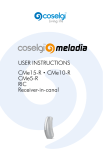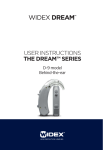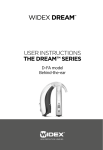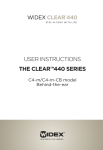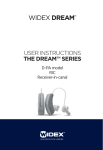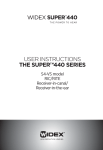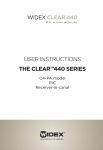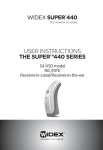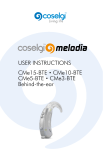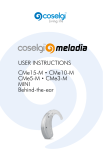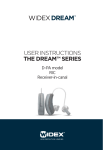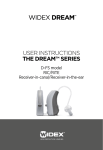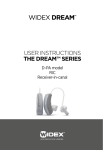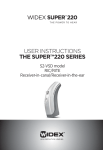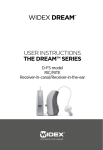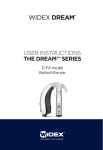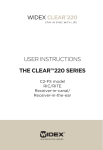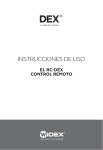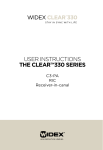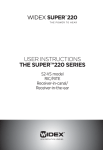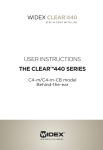Download USER INSTRUCTIONS THE CLEAR™440 SERIES
Transcript
USER INSTRUCTIONS THE CLEAR™440 SERIES C4-FS model RIC/RITE Receiver-in-canal/ Receiver-in-the-ear YOUR WIDEX CLEAR™440 HEARING AID (To be filled out by the hearing care professional) Date: ______________________________________ Battery size: ________________________________ 2 CONTENTS SYMBOLS. . . . . . . . . . . . . . . . . . . . . . . . . . . . . . . . . . . . . . . . . . . . . . 4 THE HEARING AID . . . . . . . . . . . . . . . . . . . . . . . . . . . . . . . . . . . . . . 5 Right/left identification . . . . . . . . . . . . . . . . . . . . . . . . . . . . . . . . . . 8 Acoustic indicators . . . . . . . . . . . . . . . . . . . . . . . . . . . . . . . . . . . . . . 8 The battery. . . . . . . . . . . . . . . . . . . . . . . . . . . . . . . . . . . . . . . . . . . . . 9 Inserting the battery . . . . . . . . . . . . . . . . . . . . . . . . . . . . . . . . . . 9 Low battery indication. . . . . . . . . . . . . . . . . . . . . . . . . . . . . . . . 12 Turning the hearing aid on and off . . . . . . . . . . . . . . . . . . . . . . . 13 Positioning the hearing aid . . . . . . . . . . . . . . . . . . . . . . . . . . . . . . 14 Removing the hearing aid . . . . . . . . . . . . . . . . . . . . . . . . . . . . . . 15 Volume adjustment . . . . . . . . . . . . . . . . . . . . . . . . . . . . . . . . . . . . 16 Lost partner alarm . . . . . . . . . . . . . . . . . . . . . . . . . . . . . . . . . . . . . 18 Listening programs. . . . . . . . . . . . . . . . . . . . . . . . . . . . . . . . . . . . . 19 Switching between the listening programs . . . . . . . . . . . . . . 25 Zen+ . . . . . . . . . . . . . . . . . . . . . . . . . . . . . . . . . . . . . . . . . . . . . . . 26 Phone+ . . . . . . . . . . . . . . . . . . . . . . . . . . . . . . . . . . . . . . . . . . . . . 26 Using a telephone. . . . . . . . . . . . . . . . . . . . . . . . . . . . . . . . . . . . . . 27 Cleaning . . . . . . . . . . . . . . . . . . . . . . . . . . . . . . . . . . . . . . . . . . . . . . 28 ACCESSORIES. . . . . . . . . . . . . . . . . . . . . . . . . . . . . . . . . . . . . . . . . 30 IN CASE OF MALFUNCTION . . . . . . . . . . . . . . . . . . . . . . . . . . . . . 31 CARING FOR YOUR HEARING AID. . . . . . . . . . . . . . . . . . . . . . . . 33 WARNINGS . . . . . . . . . . . . . . . . . . . . . . . . . . . . . . . . . . . . . . . . . . . 34 ADVICE . . . . . . . . . . . . . . . . . . . . . . . . . . . . . . . . . . . . . . . . . . . . . . 37 REGULATORY INFORMATION . . . . . . . . . . . . . . . . . . . . . . . . . . . . 38 3 SYMBOLS The following symbols will be used throughout the manual: WARNING Messages with this heading indicate serious adverse reactions, potential safety hazards and inadequate performance of device. CAUTION Messages with this heading indicate/include information regarding any special care to be exercised. Non-ionizing radiation Not for general waste. 4 THE HEARING AID The illustration below shows the hearing aid without the ear-set. The choice of ear-set solution depends on your specific needs. Please refer to the separate ear-set user manual. 1. 2. 3. 4. On/off switch Battery drawer with nail grip Program button LED & Right/Left ID 3 4 1/2 5 NOTE In addition to these user instructions, a separate user manual is provided describing the various ear-set solutions available for your hearing aid: “Ear-sets for Widex BTE hearing aids”. WARNING This booklet and the manual “Ear-sets for Widex BTE hearing aids” contain important information and instructions. Read these booklets carefully before you start using the hearing aid. NOTE Your hearing aid, ear-set and accessories may not look exactly as illustrated in this booklet. We also reserve the right to make any changes considered necessary. Intended use The CLEAR hearing aids are intended as air conduction amplification devices to be used in everyday listening environments. The CLEAR hearing aids may be provided with the Zen program intended to provide a relaxing sound background (i.e. music/noise source) for adults who desire to listen to such a background in quiet. Indications for use The devices are indicated for individuals with a full range of hearing loss severity from slight (16 dB HL to 25 dB HL) to severe/profound (90+ dB HL) and all hearing loss configurations. 6 They are to be programmed by licensed hearing care professionals (audiologists, hearing aid specialists, otolaryngologists) who are trained in hearing (re)habilitation as well as tinnitus management. Description of device Your CLEAR™ hearing aid is used with an ear-set which consists of an earwire and an earpiece, in which the receiver is placed. The hearing aid uses a proprietary wireless technology, WidexLink, to enable communication between the left and the right hearing aids, as well as between the hearing aids and the DEX accessories. Your hearing aid may be provided with an optional listening program called Zen. It makes musical tones (and sometimes a rushing noise) in the background. These sounds are shaped according to your hearing loss. 7 Right/left identification The arrow shows the position of the identification mark (red = right and blue = left). Acoustic indicators The hearing aid may be set to produce a signal to indicate the use of certain functions. The signal may be a spoken message or tones adjusted by the hearing care professional in consultation with you. The signal can also be deactivated. Adjusting volume (via remote control) Tone* Off Confirming program button use Clicking sound Off Changing program Message Tones Off Starting up the hearing aid Message Tone Off Warning about low battery Message 4 tones Off Warning about lost partner Message Off Service reminder Message Off * Bold indicates standard setting 8 The battery We recommend zinc-air batteries. Use a size 312 battery for the hearing aid. To obtain replacement batteries, please consult your hearing care professional. It is important to take note of the expiration date and the recommendations on the battery pack regarding disposal of used batteries. Otherwise there is a risk that the battery life may be reduced. Inserting the battery Before inserting a new battery into the hearing aid, remember to remove the adhesive tab. Once the tab has been removed, the battery will start functioning after a few seconds. CAUTION Do not use batteries if there is a sticky residue from the tab or other unwanted substance, as this can cause the hearing aid to malfunction. 9 Use the nail grip to gently swing the battery drawer completely open. Do not press the drawer beyond the open position. Place the battery in the drawer, so that the plus (+) sign on the battery faces upward. You can use the battery magnet provided to steer the battery into place. + If the battery drawer does not close easily, the battery is incorrectly inserted. When changing battery, it is a good idea to hold the hearing aid over a table. 10 The hearing aid may be provided with a battery drawer without a nail grip, which means that you need a tool to open the battery drawer. This type of drawer can be a good choice if the hearing aid is worn by a child. A special tool for opening the drawer will be included with this drawer. The battery drawer is opened as illustrated 11 Low battery indication An acoustic indicator will sound when the battery is nearly exhausted, unless this function has been disabled (see page 8). We recommend that you always have a spare battery with you. WARNING Never leave an exhausted battery in the hearing aid. Exhausted batteries may leak, damaging the hearing aid. WARNING Your hearing aid may stop functioning, for instance if the battery is exhausted. You should be aware of this possibility, in particular when you are in traffic or are otherwise dependent on warning signals. 12 Turning the hearing aid on and off The battery drawer of the hearing aid also functions as the on/off switch. Close the battery drawer to turn on the hearing aid. An acoustic indicator will indicate that the hearing aid has been switched on, unless this function has been disabled. To turn off the hearing aid, open the battery drawer slightly to the first position where a click is felt. Please remember to turn off the hearing aid when it is not in use. Remove the battery if the hearing aid will not be used for several days. 13 Positioning the hearing aid Insert the earpiece in the ear canal while holding the lower part of the earwire. It may help to pull the outer ear backwards and upwards with the opposite hand. Place the hearing aid behind the ear, so that the hearing aid and earwire rest comfortably on the ear, close to your head. The illustrations show an open ear-tip. For further information on ear-tip/earmould types, anchors and procedures, see the separate ear-set user manual provided. 14 Removing the hearing aid Remove the hearing aid from its position behind the ear. Carefully pull the earpiece out of the ear canal, while holding the lower part of the earwire. If the earpiece is provided with an extraction cord, take hold of this and carefully pull the ear-tip out of the ear canal. 15 Volume adjustment The hearing aid volume is adjusted automatically in accordance with your sound environment. If you have a remote control, you can also adjust the volume manually or mute your hearing aid. Any adjustment of the volume setting will be cancelled when your hearing aid is turned off, or when you change program. In the default setting, any volume adjustment via the remote control will affect both hearing aids. To alter the increments in which the volume is increased or decreased, consult your hearing care professional. If you have a remote control, please also refer to the user instructions for this. WARNING With a custom earmould, this hearing aid is capable of producing a sound pressure level exceeding 132 dB SPL. There may be a risk of damaging your residual hearing. CAUTION If the volume in the hearing aid is generally too loud or too weak, or the reproduced sounds are distorted, or if you would like any further information, consult your hearing care professional. 16 To mute the hearing aid with a remote control: Keep pressing the volume down key on the remote control after the long beep-tone has sounded and until it stops. Pressing one of the volume keys briefly will bring back the sound. 17 Lost partner alarm (Note: Only applicable if this feature has been activated by your hearing care professional). If one of your hearing aids falls off your ear, and/or the battery is exhausted, a tone signal and a spoken message will sound two times in the other hearing aid, and the diode will flash on both hearing aids. When the lost hearing aid is repositioned, and/or the battery is exchanged, the diodes stop flashing. 18 Listening programs Your hearing aid may be provided with five of the following programs, plus either the special Zen program called Zen+ or the Phone+ program. Master Standard Music For listening to music TV For listening to the TV Comfort Attenuates background noise Reverse focus Focus on sounds from behind Audibility Extender Makes high-frequency sounds audible Phone For listening to the telephone T In this program you listen via the telecoil (T) and not via the hearing aid microphones (M). The telecoil is used where a loop system is installed. If you activate the telecoil program, you listen to a specific sound source and shut out surrounding sounds. M+T In this program you listen via the hearing aid microphones (M) and the telecoil (T). Zen Generates different kinds of tones. Compound programs The Master program in one ear and Zen, Reverse focus, Audibility Extender, T, MT or Phone in the other. 19 Zen+ Special Zen program with up to three different Zen styles Phone+ For phone use only. Transmits the telephone sound received in one hearing aid to the other hearing aid. Note that the microphones on the hearing aid to which the sound are transmitted is turned off. If your needs change over time, the combination of listening programs can be altered. CAUTION When selecting Phone+ as listening program, please remember that there are situations in which it is particularly important to be able to hear the surrounding sounds. Zen program Your hearing aid may be provided with a unique optional listening program called Zen. It makes musical tones (and sometimes a rushing noise) in the background using the latest in fractal technology. These sounds are shaped according to your hearing loss so you can listen to them at any time and at any place with a simple push of the program button. The Zen program may be used alone (without amplification) in quiet when you are not required to hear surrounding sounds. Or, it may be used with another program so both the surrounding sounds and the generated sounds (fractal tones and noise) are heard together. 20 CAUTION Use of the different Zen programs may interfere with hearing surrounding sounds including speech. The programs should not be used when hearing such sounds is important. Switch the hearing aid to a non-Zen program in those situations. CAUTION If you perceive decrease in loudness, tolerance of sounds, speech not as clear, or worsening tinnitus, contact your hearing care professional. The duration of the Zen play time can be set by your hearing care professional according to your needs. Benefits The Zen program may provide a relaxing listening background for some people. When the Zen program is used in a tinnitus management program, its wearer may experience some relief from tinnitus. Indications for use The Zen program is intended to provide a relaxing sound background (i.e., music/noise source) for adults who desire to listen to such a background in quiet. It may be used as a sound therapy tool in a tinnitus treatment program that is prescribed by a hearing care professional (audiologists, hearing aid specialists, otolaryngologists) who is trained in tinnitus management. 21 Directions for use The Zen program can be activated with a simple push of the program button on the hearing aid (or on the remote control). Depending on how your hearing care professional has set up the program, you can access the Zen program by a “short-press” of the program button or a “long-press” of the program button. • “Short-press” option – the program button is pressed for less than a second. At most two listening programs can be programmed for Zen. • “Long-press” option – the program button is pressed and held for more than 1 second. Up to three Zen styles are available. A “short-press” of the program button in the long-press mode will allow you to cycle through the available Zen styles. You can exit the “long-press” mode by pressing and holding the program button for more than a second. Because of the unique ways in which Zen is programmed in your hearing aid, please follow the recommendations of your hearing care professionals as to how to use the program, when to use the program and/ or how long to use the program. 22 Precautions To ensure the safety and effectiveness of the Zen program when used as a sound therapy tool for tinnitus, the tinnitus management program must be designed and conducted by hearing care professionals who are trained in tinnitus management. A tinnitus management program should include a complete audiological evaluation, tinnitus diagnosis, counseling, use of proper amplification and/or sound therapy tools. Prior to any tinnitus management program, it is advisable that you seek medical attention to exhaust any medical or surgical treatment options. Use your hearing aid and the Zen program according to the directions and schedule recommended by your hearing care professionals. Warnings Use of the Zen program may interfere with hearing everyday sounds including speech. It should not be used when hearing such sounds is important. Switch the hearing aid to a non-Zen program in those situations. 23 Risks There are no known risks or side effects associated with the use of the Zen program. However, consistent with our recommendations on the use of conventional hearing aids, stop using the hearing aids (and the Zen program) and seek attention from your hearing care professional if any of the following symptoms are noted: • Skin irritation • Perceived decrease in loudness, tolerance of sounds, speech not as clear, or worsening tinnitus 24 Switching between the listening programs Each time you switch to another program, an acoustic indicator will sound unless this function has been disabled. Program 1: Program 2: Program 3: Program 4: Program 5: Zen+: Phone+: Message or one short beep Message or two short beeps Message or three short beeps Message or one long and one short beep Message or one long and two short beeps Message or tone or Message or tone In the default setting, both your hearing aids will be affected when you change programs. 25 Zen+ This program is accessed via a long press (two secs.) on the program button on the hearing aid or the RC-DEX. A short press then allows you to cycle through the available Zen styles. You can exit Zen+ by pressing and holding the program button for two seconds. Phone+ This program is accessed via a long press (two secs.) on the program button on the hearing aid. You can exit Phone+ by pressing and holding the same program button for two seconds. If you wish to have the program button disabled, please consult your hearing care professional. 26 Using a telephone When using a telephone, we recommend that you hold the telephone against your head at an angle above your ear, rather than directly against the ear. If the sound is not optimal, try moving the telephone earpiece to a slightly different position. 27 Cleaning The following cleaning accessories are available for the hearing aid and ear-set*. For cleaning the ear-set, see the user manual “Ear-sets for Widex BTE hearing aids”. 1. Cloth 2. Wax removing tool 3. Brush 1 2 3 Contact your hearing care professional if you need additional supplies of cleaning accessories. * Selection depends on your ear-set solution 28 Clean the hearing aid with the soft cloth after use. WARNING Never use water or cleaning solutions to clean the hearing aid, as this may cause it to malfunction. When the hearing aid is not in use, the battery drawer should be left open, to ventilate the hearing aid and allow it to dry. 29 ACCESSORIES A variety of assistive listening devices are available for your hearing aid. • RC-DEX • TV-DEX • M-DEX For help in determining whether you could benefit from a remote control or other accessories, please consult your hearing care professional. 30 IN CASE OF MALFUNCTION The following pages contain some quick advice on what to do if your hearing aid stops working or performs unsatisfactorily. If the problems persist, contact your hearing care professional for assistance. See the “Ear-sets for Widex BTE hearing aids” user manual for information specific to your ear-set. Problem Potential cause Solution The hearing aid is completely silent The hearing aid is not turned on Make sure the battery drawer is completely closed The battery does not Insert a new battery in work the hearing aid The hearing aid volume is not powerful enough The hearing aid whistles continuously The battery is nearly Insert a new battery in exhausted the hearing aid Your ear is blocked by earwax Contact your ENT doctor/physician Your hearing may have changed Contact your hearing care professional Your ear is blocked by earwax Contact your ENT doctor/physician 31 Problem Potential cause Solution Your two hearing aids are not working in synchrony The connection between the hearing aids is lost Turn the hearing aids off and on again The hearing a. The DEX is used a. Move the DEX closer aids do not beyond the transto the CLEAR hearing respond with mission range aids a correspond- b. Strong electrob. Move away from ing change in magnetic interferknown source of EM volume or ence in the viciniinterference program to ty the DEX c. The DEX and the c. Check with dispenser CLEAR hearing to make sure DEX is aids are not matched with CLEAR matched hearing aids You hear “interrupted” speech (on and off) from the hearing aids or no speech (muted) from the transmitting ear. a. The battery in one a. Replace battery in of the hearing aids one or both hearing has expired aids b. Strong electrob. Move away from magnetic interferknown sources of inence in the viciniterference ty 32 CARING FOR YOUR HEARING AID The hearing aid is a valuable object and should be treated with care. Here are some things you can do to prolong the life of your hearing aid: CAUTION • Turn off your hearing aid when it is not in use. Remove the battery if the hearing aid will not be used for several days. • When the hearing aid is not in use, keep it in its case in a cool, dry location out of reach of children and pets. • Do not expose the hearing aid to extreme temperatures or high humidity. Make sure to dry the hearing aid thoroughly after heavy perspiration such as that which may occur during intense physical activity, e.g. playing sports. • Avoid dropping your hearing aid – perform cleaning and battery changes while holding the hearing aid above a soft surface. • Do not wear your hearing aid while in the shower or swimming, or when using a hair dryer, perfume, hair and body sprays or gels such as suntanning lotions or creams. • In environments with high humidity, a drying kit may be used daily to reduce the amount of moisture inside the hearing aid. See the instructions enclosed with the drying kit. 33 WARNINGS WARNING Hearing aids and batteries can be dangerous if swallowed or used improperly. Swallowing or improper use can result in severe injury or even fatalities. In case of ingestion, contact a physician immediately and the 24 Hour National Button Battery Ingestion Hotline at (202) 625-3333. • Keep hearing aids and their parts, accessories and batteries out of reach of children and anyone else who might swallow such items or otherwise cause injury to themselves. Do not change batteries in front of them and do not let them see where you keep your battery supply. Discard used batteries carefully. • Batteries are very small and can easily be mistaken for pills or the like. Never put a battery or hearing aid in your mouth for any reason as you may risk swallowing it. 34 WARNING • Risk of explosion if battery is replaced by an incorrect type or recharged. Dispose of used batteries according to the instructions. • Never allow others to wear your hearing aid, as this could cause permanent damage to their hearing. • When selecting a listening program, please remember that there are situations in which it is particularly important to be able to hear the surrounding sounds (e.g. traffic, warning signals). • The hearing aid is made of modern non-allergenic materials. Nonetheless, in rare cases skin irritation may occur. If you notice skin irritation in or around your ear or ear canal, contact your hearing care professional. • Be aware that the use of any type of hearing aid may involve a slightly increased risk of infection in the ear canal. An infection can arise as a result of inadequate ventilation of the ear. We therefore recommend that you remove the hearing aid and ear-set from your ear at night to allow the ear canal to be ventilated. Make sure that you clean and inspect your hearing aid and ear-set as required. If an infection occurs, you should seek medical attention and contact your hearing care professional for advice on how to disinfect the various hearing aid parts. Do not under any circumstances use alcohol, chlorine or similar substances. • Do not use Widex hearing aids in mines or other areas with explosive gases. 35 WARNING • Do not wear your hearing aid during radiation, X-rays, MRIs, CT or other medical treatments and scans. The emissions from these procedures as well as from other types of radiation, such as that in a microwave oven, can damage your hearing aid. Radiation from, for example, room surveillance equipment, burglar alarms and cell phones is weaker and will not damage the hearing aid, but may create audible interference. CAUTION • Your hearing aid has been tested for interference according to international standards. Nevertheless, it is possible that unforeseen interference may occur in the hearing aid due to electromagnetic radiation from other products such as alarm systems, room surveillance equipment and cell phones. • Although your hearing aid has been designed to comply with the most stringent international electromagnetic compatibility standards, the possibility cannot be excluded that it may cause interference with other equipment, such as medical devices. • Never try to open or repair the hearing aid yourself. 36 ADVICE NOTE • The hearing aid will not restore normal hearing and will not prevent or improve a hearing loss resulting from organic conditions. However, the hearing aid can help you to make the best possible use of your remaining hearing ability. You should also bear in mind that it can take time to get used to a new hearing aid and new sounds. • In most cases, using the hearing aid infrequently will not permit you to gain full benefit from it. • The use of a hearing aid is only part of hearing habilitation and may need to be supplemented by auditory training and instruction in lipreading. • The use of hearing aids increases the risk of accumulation of earwax. Contact your physician/ENT doctor if you suspect that a plug of earwax has accumulated in your ear. Earwax may not only reduce your own hearing but also the effect of the hearing aid considerably. It is a good idea to ask your physician to clean your ears a couple of times a year. 37 REGULATORY INFORMATION The following Table summarizes the technical details of the WidexLink technology as it is implemented in the CLEAR™ hearing aids. Hearing aids RC-DEX TM-DEX Bluetooth* - NOAHlink Antenna type Inductive antenna Inductive antenna Inductive antenna Embedded ceramic antenna Antenna dimensions Ø1.8 mm, Ø8 mm, Ø6 mm, L - 4.85 mm L – 20 mm L - 8 mm NA Modulation FSK FSK FSK FHSS/ GFSK, π/4 DPSK, 8 DPSK Magnetic Field Strength (at 10 m distance) -54 dBμA/m -13 dBμA/m -26 dBμA/m NA Output power (EIRP**) 29 pW 21 nW 1.2 nW +4dB re. 1mW Range < 1 m remote unit to hearing aid < 30 cm between hearing aids or Hearing aid to TM-DEX < 1 m remote unit to hearing aid < 30 cm between hearing aid and TM-DEX < 10 m between PC and NOAHlink 10.6 MHz 10.6 MHz 2.4 GHz Center 10.6 MHz frequency 38 Hearing aids RC-DEX TM-DEX Bluetooth* - NOAHlink Channel Single channel radio Single channel radio Single channel radio 5 logical channels Bandwidth 660 kHz (-15 dB) 660kHz (-15 dB) 660kHz (-15 dB) 1 MHz Data-rate 212 kbit/ second (raw channel capacity) 212 kbit/ second (raw channel capacity) 212 kbit/ 2.1 Mbps second (raw channel capacity) Data flow Simplex or Simplex semi-duplex capability capability Simplex or Time divisemi-duplex sion duplex capability (TDD) Random Access – no collision avoidance Random Access – no collision avoidance Packetbased protocol, time divided; secure Serial Port Profile (SPP) * Bluetooth specification v2.0 + EDR published by the Bluetooth Special Interest Group (SIG). ** EIRP = Equivalent isotropically radiated power. Protocol Random Access – no collision avoidance Bluetooth Identifier: B01837 Reference number of QPN: NOAHlinkV1.2_412832_QPN_E1 39 (Benefits) The use of wireless transmission allows convenient and synchronized control of hearing aid functions. The CLEAR wireless hearing aids share input information between the two partner hearing aids. In so doing, the wearers would experience the following additional user benefits (only when wearing binaural CLEAR hearing aids). Synchronization of volume control settings between hearing aids – The volume in both hearing aids will change when the VC is adjusted on one ear. Synchronization of listening programs between hearing aids – The same listening program is used in both hearing aids when one is changed by the user. Surveillance of partner hearing aid – The hearing aid(s) will signal an alert (“partner check”) when a hearing aid battery has expired, or that one of the hearing aids has fallen off. In rare instances, a much stronger wireless source nearby may activate this alert. This serves as an early warning to the wearer of such service interruption. Coordination of compression – The CLEAR hearing aids maintain the intensity level difference between ears (inter-aural level difference, ILD). In some situations where speech is presented to one side and noise the other side, this coordinated action could enhance the relative loudness of the speech sounds to the noise background and improve speech understanding for some wearers. More accurate identification of feedback – The CLEAR hearing aids distinguish between “true” hearing aid whistling (or feedback) and music sounds to prevent unnecessary feedback cancellation and preserve natural sound quality. 40 (Contraindications): • Congenital or traumatic deformity of the ear • Active drainage from the ear within 90 days • History of rapid progressive hearing loss within previous 90 days • Acute or chronic dizziness • Sudden unilateral hearing loss in previous 90 days CAUTION (Risks) The use of the CLEAR/DEX should not interfere with other devices such as a pacemaker. However, to be extra cautious, Widex follows the guidelines recommended by the manufacturers of implantable defibrillators and pacemakers for their patients when using cell phones. Specifically, hearing aid wearers who also use a pacemaker should • Keep the hearing aids at a distance of at least 15 cm/6 inches away from the pacemaker and • Do not carry the hearing aids (and/or any of the DEX accessories) in a shirt pocket or close to the chest. • If any interference is observed, do not use the hearing aids (and/or DEX) and contact your pacemaker manufacturer and hearing healthcare professional immediately. 41 RADIO TRANSMITTER / CABLES / TRANSDUCERS The CLEAR™ series hearing aid contains a radio transmitter / receiver with the following Radio transmitter parameters: • Frequency (range): 10.6 MHz (10.2 – 11.0 MHz) • Bandwidth (-15dB): 660 kHz • Channel: Single channel radio • Modulation: FSK • Radiated output power: 29 pW / -75 dBm • Magnetic field strength: -54 dBμA/m @ 10 m • Duty Cycle: < 5 % (averaged over 1 hour of operation) • Simplex or semi duplex capability The radio receiver in the CLEAR™ series hearing aid is using the same frequency and bandwidth as the transmitter. Cables and transducers: No cables and transducers are used neither during normal use of the CLEAR™ series hearing aid nor during programming of the hearing aid. 42 QUALITY OF SERVICE FOR WIRELESS TECHNOLOGY IN THE WIDEXLINK SYSTEM WidexLink wireless technology enables communication between two partners of a binaural pair of CLEAR hearing aids and with their matched external devices. The requirements for the quality of service (QoS) vary among the various components and their intended user scenarios. For programming, these requirements include a BER (Bit Error Rate) better than 10-3, at a bitrate of 212 kbits/s, a semi-duplex transmission with a required acknowledge, a transmission latency in each direction (2x) and a receive-to-transmit mode (RX to TX) time. The data are saved in the hearing aid even when transmission is interrupted. During daily use, the requirements on audio streaming between hearing aids include a BER better than 10-3. The communication is simplex with a bitrate of 212 kbits/s. The additional audio decoding in this mode results in a longer latency which is less than 10 ms. For remote control commands the QoS requirements include a BER better than 10-2. The lower BER requirement results from redundant transmissions. Each key press results in transmissions of 7 data packages of which only one is needed for a successful communication. For inter-ear communication between hearing aids, a BER better than 10-3 is required. The communication is updated every 50 ms (or 20 Hz). The hearing aids continue to amplify based on the last saved settings even when the transmission range is exceeded or when communication is interfered. 43 Wireless Security Measures Security of the wireless signals is assured through device system design that includes: • Individual MAC address for each unit which is checked during each transmission. • A built-in pairing table which specifies valid and legitimate pairing among units • A proprietary Widex communication protocol which checks the package numbers during each transmission. • A Cyclic Redundancy Check (CRC) to check data validity and correct errors. 44 GUIDANCE AND MANUFACTURER’S DECLARATION Electromagnetic emissions The CLEAR™ series hearing aids are intended for use in the electromagnetic environment specified below. The customer or the user of a CLEAR™ series hearing aid should assure that it is used in such an environment. Emissions test Compliance Electromagnetic environment - guidance RF emissions CISPR 11 Group 2 The CLEAR™ hearing aid must emit electromagnetic energy in order to perform its intended function. Nearby electronic equipment may be affected. RF emissions CISPR 11 Class B Harmonic emissions IEC 61000-3-2 Voltage fluctuations/ flicker emissions IEC 61000-3-3 The CLEAR™ hearing aid is suitable for use in all establishments, including domestic esNot tablishments and those directly applicable *) connected to the public low-voltage power supply netNot work that supplies buildings applicable *) used for domestic purposes. *) Battery powered equipment 45 Electromagnetic immunity The CLEAR™ series hearing aids are intended for use in the electromagnetic environment specified below. The customer or the user of a CLEAR™ series hearing aid should assure that it is used in such an environment. Immunity Test IEC 60601 Test level Compliance level Electromagnetic environment – guidance Electrostatic ± 6 kV condischarge tact (ESD) ± 8 kV air IEC 61000-4-2 ± 6 kV contact Floors should be ± 8 kV air wood, concrete or ceramic tile. If floors are covered with synthetic material, the relative humidity should be at least 30 %. Electrical fast transients/burst IEC 61000-4-4 ± 2 kV for power line supplies ± 1 kV for input/output lines Not applicable *) Surge IEC 61000-4-5 ± 1 kV line(s) to line(s) Not applicable *) Not applicable *) Not applicable *) ± 2 kV line(s) Not to earth applicable *) 46 Not applicable *) Immunity Test IEC 60601 Test level Compliance level Electromagnetic environment – guidance Voltage dips, short interruptions and voltage variations on power supply input lines IEC 61000-4-11 <5 % UT (>95 % dip in UT) for 0.5 cycle 40 % UT (60 % dip in UT) for 5 cycles 70 % UT (30 % dip in UT) for 25 cycles <5 % UT (>95 % dip in UT) for 5 s Not applicable *) Not applicable *) Power frequency (50/60 Hz) magnetic field IEC 61000-4-8 3 A/m 3 A/m Power frequency magnetic fields should be at levels characteristic of a typical location in a typical commercial or hospital environment NOTE UT is the a.c. mains voltage prior to the application of the test level. *) Battery powered equipment 47 Electromagnetic immunity – cont. The CLEAR™ series hearing aids are intended for use in the electromagnetic environment specified below. The customer or the user of a CLEAR™ series hearing aid should assure that it is used in such an environment. Immunity Test IEC 60601 CompliElectromagnetic environTest level ance level ment – guidance Portable and mobile RF communications equipment should be used no closer to any part of the CLEARTM series hearing aid, including cables, than the recommended separation distance calculated from the equation applicable to the frequency of the transmitter. Conducted 3 Vrms RF 3 Vrms Recommended separation distance d = 1.2 √P IEC 150 kHz to 61000-4-6 80 MHz Radiated RF 3 V/m IEC 61000-4-3 80 MHz to 2.5 GHz 3 V/m d = 1.2 √P 80 MHz to 800 MHz d = 2.3 √P 800 MHz to 2.5 GHz 48 Immunity Test IEC 60601 CompliElectromagnetic environTest level ance level ment – guidance Where P is the maximum output power rating of the transmitter in watts (W) according to the transmitter manufacturer and d is the recommended separation distance in meters (m). Field strengths from fixed RF transmitters, as determined by an electromagnetic site survey a, should be less than the compliance level in each frequency range b. Interference may occur in the vicinity of equipment marked with the following symbol: 49 NOTE 1 At 80 MHz and 800 MHz, the higher frequency range applies. NOTE 2 These guidelines may not apply in all situations. Electromagnetic propagation is affected by absorption and reflection from structures, objects and people. a. Field strengths from fixed transmitters, such as base stations for radio (cellular/cordless) telephones and land mobile radios, amateur radio, AM and FM radio broadcast and TV broadcast cannot be predicted theoretically with accuracy. To assess the electromagnetic environment due to fixed RF transmitters, an electromagnetic site survey should be considered. If the measured field strength in the location in which the CLEAR™ series hearing aid is used exceeds the applicable RF compliance level above, the CLEAR™ series hearing aid should be observed to verify normal operation. If abnormal performance is observed, additional measures may be necessary, such as re-orienting or re-locating the CLEAR™ series hearing aid. b. Over the frequency range 150 kHz to 80 MHz, field strengths should be less than 3 V/m. Recommended separation distances Recommended separation distances between portable and mobile RF communication equipment and the CLEAR™ series hearing aids. The CLEAR™ series hearing aids are intended for use in the electromagnetic environment in which RF disturbances are controlled. The customer or the user of the CLEAR™ series hearing aid can help prevent electromagnetic interference by maintaining a minimum distance between portable and mobile RF communications equipment (transmitters) and the CLEAR™ hearing aids as recommended below, according to the maximum output power of the communications equipment. 50 Rated maximum output power of transmitter (W) Separation distance according to frequency of transmitter (m) 150 kHz to 80 MHz d = 1.2 √P 80 MHz to 800 MHz d = 1.2 √P 800 MHz to 2.5 GHz d = 2.3 √P 0.01 0.12 0.12 0.23 0.1 0.38 0.38 0.73 1 1.2 1.2 2.3 10 3.8 3.8 7.3 100 12 12 23 For transmitters rated at a maximum output power not listed above, the recommended separation distance d in meters (m) can be estimated using the equation applicable to the frequency of the transmitter, where P is the maximum output power rating of the transmitter in watts (W) according to the transmitter manufacturer. NOTE 1 At 80 MHz and 800 MHz, the higher frequency range applies. NOTE 2 These guidelines may not apply in all situations. Electromagnetic propagation is affected by absorption and reflection from structures, objects and people. This CLEAR™ hearing aid may be interfered with by other equipment even if that other equipment complies with CISPR emission requirements. 51 (EMI/EMC Compliance). The CLEAR™ hearing aid complies with the following EMC/EMI standards: Standard Test type Note 47 CFR Part 15, subpart C RF emissions USA Federal Communications Commission (FCC) requirements for intentional radiators. EN 303 330-2 RF emissions V1.3.1 incl. Spurious emission EMC and radio spectrum matters for Short Range Devices in the frequency range 9 kHz – 25 MHz IEC 60601-12:2007 *adapted protocol EMC emission Immunity, RF and ESD Medical electrical equipment. General requirements for basic safety and essential performance. Electromagnetic compatibility. EN 301 489-3 Immunity, RF V1.4.1 and ESD Standard for Low Power Transmitters in the frequency range 9 kHz – 40 GHz IEC 6011813:2004 Immunity RF Near Field immunity test International Product std. for hearing aids to ensure adequate immunity to radio interference from cell telephones. ANSI C63.192001 Immunity RF Near Field immunity test American National Standard Methods of measurement of Compatibility between wireless Communication Devices and Hearing Aids * The device was tested in only one orientation that represents the longest length (or worst case scenario). This is acceptable because of the relative small size of the device compared to the wavelength of the RF used in the test. 52 IMPORTANT NOTICE FOR PROSPECTIVE HEARING AID USERS Good health practice requires that a person with a hearing loss have a medical evaluation by a licensed physician (preferably a physician who specializes in diseases of the ear) before purchasing a hearing aid. Licensed physicians who specialize in diseases of the ear are often referred to as otolaryngologists, otologists, or otorhinolaryngologists. The purpose of medical evaluation is to assure that all medically treatable conditions that may affect hearing are identified and treated before the hearing aid is purchased. Following the medical evaluation, the physician will give you a written statement that states that your hearing loss has been medically evaluated and that you may be considered a candidate for a hearing aid. The physician will refer you to an audiologist or a hearing aid dispenser, as appropriate, for a hearing aid evaluation. The audiologist or hearing aid dispenser will conduct a hearing aid evaluation to assess your ability to hear with and without a hearing aid. The hearing aid evaluation will enable the audiologist or dispenser to select and fit a hearing aid to your individual needs. If you have reservations about your ability to adapt to amplification, you should inquire about the availability of a trial-rental or purchase-option program. Many hearing aid dispensers now offer programs that permit you to wear a hearing aid for a period of time for a nominal fee after which you may decide if you want to purchase the hearing aid. Federal law restricts the sale of hearing aids to those individuals who have obtained a medical evaluation from a licensed physician. Federal law permits a fully informed adult to sign a waiver statement declining the medical evaluation for religious or personal beliefs that preclude consultation with a physician. The exercise of such a waiver is not in your best health interest and its use is strongly discouraged. 53 Children with hearing loss In addition to seeing a physician for a medical evaluation, a child with a hearing loss should be directed to an audiologist for evaluation and rehabilitation since hearing loss may cause problems in language development and the educational and social growth of a child. An audiologist is qualified by training and experience to assist in the evaluation and rehabilitation of a child with a hearing loss. 54 FCC ID: TTY-C4FS IC: 5676B-C4FS Federal Communications Commission Statement This device complies with part 15 of the FCC Rules. Operation is subject to the following two conditions: (1) This device may not cause harmful interference, and (2) this device must accept any interference received, including interference that may cause undesired operation. NOTE: This equipment has been tested and found to comply with the limits for a Class B digital device, pursuant to part 15 of the FCC Rules. These limits are designed to provide reasonable protection against harmful interference in a residential installation. This equipment generates, uses and can radiate radio frequency energy and, if not installed and used in accordance with the instructions, may cause harmful interference to radio communications. However, there is no guarantee that interference will not occur in a particular installation. If this equipment does cause harmful interference to radio or television reception, which can be determined by turning the equipment off and on, the user is encouraged to try to correct the interference by one or more of the following measures: — Reorient or relocate the receiving antenna. 55 — Increase the separation between the equipment and receiver. — Connect the equipment into an outlet on a circuit different from that to which the receiver is connected. — Consult the dealer or an experienced radio/TV technician for help. NOTE: This equipment complies with FCC radiation exposure limits set forth for an uncontrolled environment. This transmitter must not be co-located or operating in conjunction with any other antenna or transmitter. Changes or modifications to the equipment not expressly approved by Widex could void the user’s authority to operate the equipment. Industry Canada Statement / Déclaration d’industrie Canada Under Industry Canada regulations, this radio transmitter may only operate using an antenna of a type and maximum (or lesser) gain approved for the transmitter by Industry Canada. To reduce potential radio interference to other users, the antenna type and its gain should be so chosen that the equivalent isotropically radiated power (e.i.r.p.) is not more than that necessary for successful communication. 56 This device complies with Industry Canada licenceexempt RSS standard(s). Operation is subject to the following two conditions: (1) this device may not cause interference, and (2) this device must accept any interference, including interference that may cause undesired operation of the device. Conformément à la réglementation d’Industrie Canada, le présent émetteur radio peut fonctionner avec une antenne d’un type et d’un gain maximal (ou inférieur) approuvé pour l’émetteur par Industrie Canada. Dans le but de réduire les risques de brouillage radioélectrique à l’intention des autres utilisateurs, il faut choisir le type d’antenne et son gain de sorte que la puissance isotrope rayonnée équivalente (p.i.r.e.) ne dépasse pas l’intensité nécessaire à l’établissement d’une communication satisfaisante. Le présent appareil est conforme aux CNR d’Industrie Canada applicables aux appareils radio exempts de licence. L’exploitation est autorisée aux deux conditions suivantes : (1) l’appareil ne doit pas produire de brouillage, et (2) l’utilisateur de l’appareil doit accepter tout brouillage radioélectrique subi, même si le brouillage est susceptible d’en compromettre le fonctionnement. 57 Hereby, Widex A/S declares that this C4-FS is in compliance with the essential requirements and other relevant provisions of Directive 1999/5/EC. A copy of the Declaration of Conformity can be found at: http://www.widex.com 58 Hearing aids, accessories and batteries should not be disposed of with normal household waste. Please consult your national Widex distributor for advice on how to dispose of these items. 59 Manufacturer CIB205/1110 ¡9 514 0165 041Y¤ ¡#01v¤ Printed by HTO / 2011-10 9 514 0165 041 #03




























































